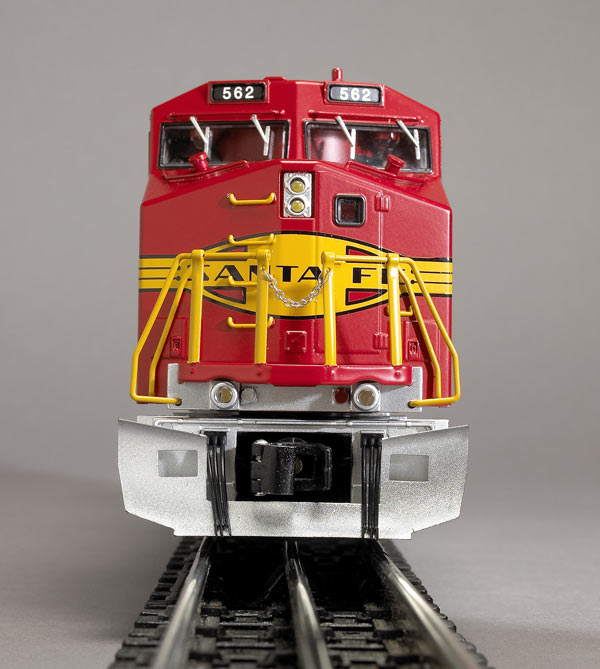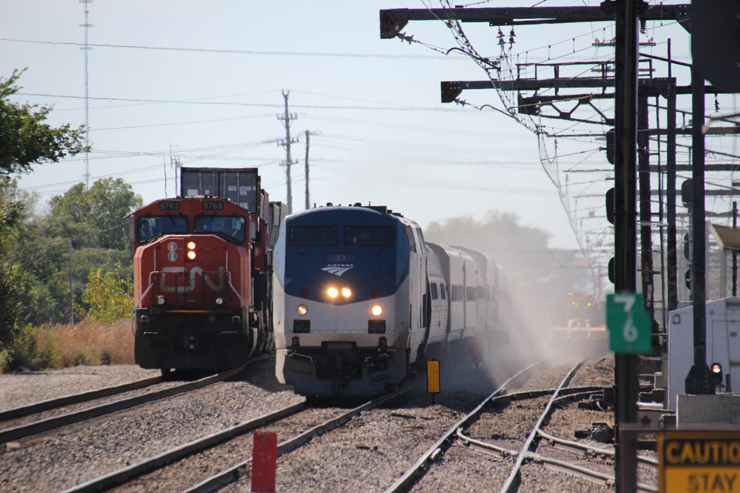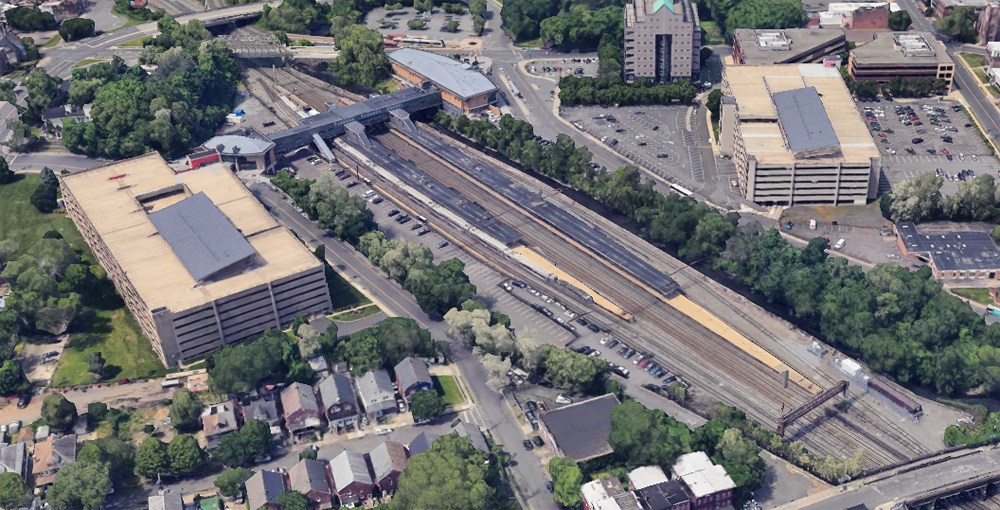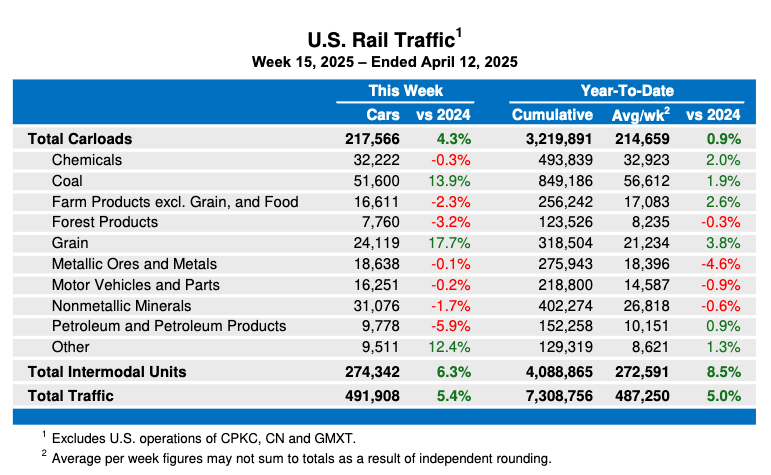Standing by for our examination today are Lionel nos. 28698 Santa Fe Dash 8-40BW powered unit and 28270 unpowered unit. Both O gauge models are identical on the outside, with the dummy version having coil couplers, directional lighting, and a fan-driven smoke unit.
Opening the box
This Lionel product is a first-rate model of a familiar carbody design. The GE Dash 8 series of locomotives have been successes in the prototype world as well as in three-rail modeling. Personally, I tend to be a six-axle man, but the overall size of this carbody is large, not at all dinky.
The pilot has the many things you have come to expect from a modern model: snowplow, brake and multiple-unit cables, add-on grab irons and safety chain. The front lacks a drawbridge, though the rear pilot has a metal bit permanently affixed in the down position to represent the drawbridge.
The locomotive’s nose has add-on handrails and grab irons and a window for the cast-in door. On the downward angles of the nose, you’ll find two sand filler caps and two grab irons.
The cab front windows have black accent paint around them, and each pane has two wiper arms. The side windows don’t open, but the frames are painted silver. Grab irons are positioned above each window.
The roof of the cab has safety tread texture, another grab iron, and a simulated antenna. Along the roof, you’ll find cast-in rivet and lift ring detail. Four inches behind the cab you’ll find two add-on lift rings on either side. On the fireman’s side at the “notch” behind the cab, two add-in grab irons are installed.
The body section beneath the add-on horn is held in place with magnets. It conceals the battery holder, the volume control and RailSounds/SignalSounds, smoke unit on/off, run/program, and Odyssey speed-control on/off switches.
The carbody detail is nicely cast, with good latch detail. The screens along the side of the body are all solid, but they have black accent paint and look great. There are 13 sets of accent-painted screens on the engineer’s side and another 13 on the opposite side. The radiator wings at the rear are wire screens placed over a black base. This is so much nicer than saving a buck or two and simply painting the body in a color appropriate to the road name.
Painting and decoration are, with a single exception, quite good. The colors were applied cleanly and neatly, and we saw no signs of overspray. Virtually all the bits of nomenclature (red-on-white, black-on-white, and black-on-silver lettering) were easily readable.
The intricate Warbonnet/SuperFleet paint scheme was well executed, with red and silver separated by yellow and black safety stripes. The Santa Fe logo on the nose is as good as they come.
We found only one negative aspect about this model; unfortunately, it was the first thing everybody noticed: the silver paint. No fewer than 10 staffers from Classic Toy Trains, Model Railroader, Trains, and Classic Trains magazines took it upon themselves to tell me that the silver paint was incorrect. Our samples had sort of a glittery bright silver paint. The Santa Fe specified a creamy silver-gray paint for its locomotives. Perhaps the paint hadn’t been mixed well enough before being applied. I’ve experienced the same thing when I haven’t gotten my can of Tamiya aerosol properly shaken before spraying.
This wasn’t a deal-breaker for any of us, but if you are a Santa Fe purist, you may want to eyeball the Dash 8-40BW before you take it home. One office wag suggested that it made the locomotive a candidate for extreme weathering.
On the test track
With the exception of a few issues in the late 1990s, we have reported the high/low speeds taken in conventional mode. This was to establish a standard for reviews, since the majority of CTT’s readers operate in conventional mode and not all locomotives have command control (but all locomotives will operate in conventional mode). Starting with this issue we’ll be including a low-speed average for command-mode testing.
The speed performance numbers for the Dash 8 were very good.
In conventional mode, the twin-motored diesel had a low-speed average of 6.1 scale mph.
Using the Legacy command system for command mode operation, we had a low-speed average of 1.9 scale mph.
The model’s high-speed average was 109 scale mph.
Drawbar pull for the diesel was 1 pound, 12 ounces.
Smoke output for both the powered and unpowered units was adjustable via the Legacy controller. On high, the output is no less than prodigious. We’re talking about riot police tear gas dispenser quantities!
Well, in 1:48 scale, of course.
The coil couplers functioned well, as did the crew announcements.
Jumping ahead without reading the instructions that come with this Lionel locomotive, we did encounter an oddity when we loaded the Legacy modules. We first loaded the powered unit, and next loaded the module for the unpowered unit. Without thinking that both units were locomotive 1, the dummy unit overwrote the powered unit in the Legacy controller.
You’ll need to change the address of one or the other model to respond to a different cab number.
I can’t say that I liked the horn (and I wasn’t alone). The Dash 8 is such a nice-looking, physically imposing model, that it needs a robust “clear-the-right-of-way” horn. The sound we heard might be prototypical for the Santa Fe Dash 8-40BW, but to me it would have sounded at home on a GP7. It just didn’t have any pizzazz.
Variations of the horn signal/tone via the horn button were fun, but operating the horn could have been more fun with a different digital horn set.
All things considered, this is a good locomotive. My unhappiness with the horn and paint was trivial. The Dash 8-40BW pulls well, has first-rate low-speed performance, and boasts all the bells and whistles that we’ve come to expect from modern O gauge locomotion. This is a great candidate for any modern-era model railroad.
Price: $499.95 (no. 28269 powered unit), $219.95 (no. 28270 unpowered)
Features: O-36 operation, powered unit has two can-style motors, Legacy command and sound systems, smoke unit, and coil couplers; unpowered unit has lights and smoke unit.













